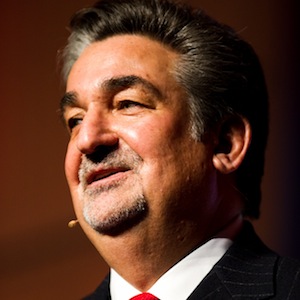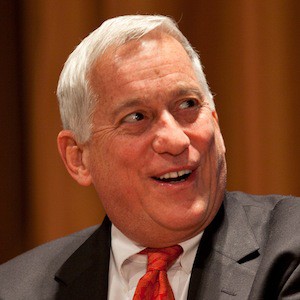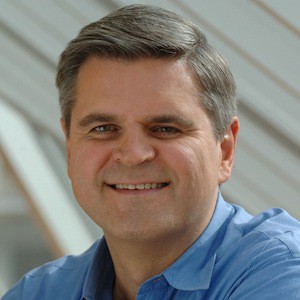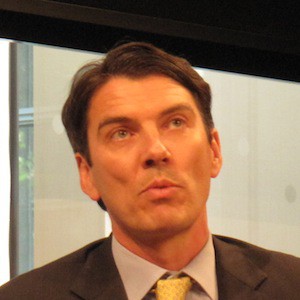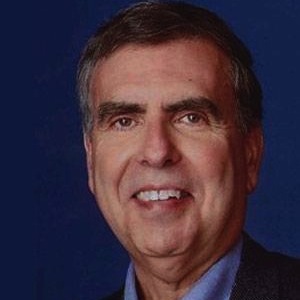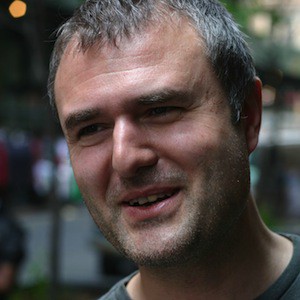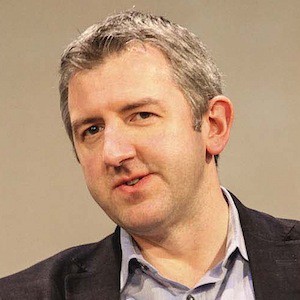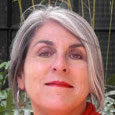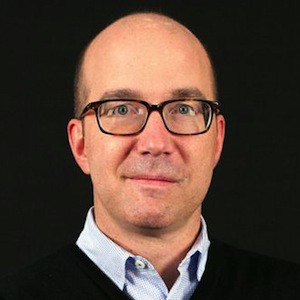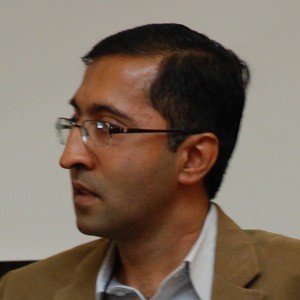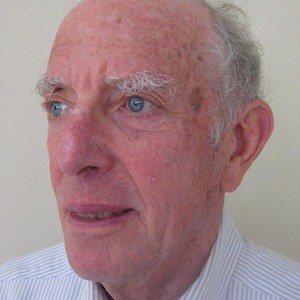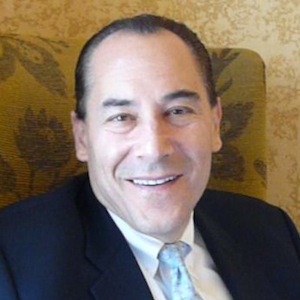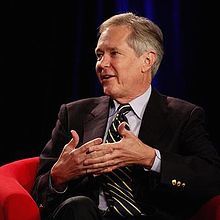Martin: April 4th, 2013, Paul Sagan, John Huey, Martin Nisenholtz speaking with Ted Leonsis. It’s great to be here.
Paul: At the Verizon Center.
Ted: Thank you. I’m very fond of everybody here. We’re like cockroaches.
[laughter]
Ted: We’ve survived all the nuclear winters. [laughs]
Paul: Still standing. So, maybe go back to…You and I met in the AOL days.
Martin: I want to go back before then. We first met when you were at Redgate. Take us through when you first realized that some form of digital technology was…You were at Wang, maybe? When did the light bulbs go on here, Ted?
Ted: In 1976, I was a student at Georgetown University, and I had to write a thesis. All Georgetown students, because of the Jesuits, have to write a thesis. I was assigned a mentor. He was a 75 year old Jesuit priest, the least technically astute person you could imagine. I had to find a subject to write about, so I went to the library to find the smallest book I could find.
I was successful in finding “Old Man and the Sea.” I pulled “Old Man and the Sea.” It was my kind of book. The first chapter was, “It was a good day. The sun was hot. The water blue.” Chapter two…So I really liked the book, and I then went back to the library to get another book by Hemingway. The second book I got was “Across the River and Into the Trees.” Totally different, like 600 pages and long run on sentences and 100 page chapters.
I came up with this concept that maybe Hemmingway had written “Old Man in the Sea” early in his career, when he was a journalist. He used to write for Esquire and was on the battlefields and filing reports and the like. He started to write books, and he needed some money, and he went back to what he knew best, a journalistic style of writing.
I mentioned that as an idea to Father Durkin, and he said, “Why don’t we use a computer?” It’s 1976. There was one computer on the campus at Georgetown University, an IBM 360 mainframe computer, in the registrar’s office.
I participated in perhaps the first real mash up, interdisciplinary, connecting the dots. We brought in a graduate student who was a linguistics major and then the one guy on campus who could program, and we created an algorithm. I was forced to type in the first 5,000 words of articles and books throughout Hemmingway’s career, and then of “Old Man and the Sea” as a control.
The linguistics major created the 17 measures words per sentences, sentences per paragraph, pronoun references. We put it all into this big computer, punch cards, and what was spit out was that Hemmingway wrote “Old Man in the Sea” in the ’30s and dressed it up a little bit and published it in the ’50s, won the Pulitzer Prize, it was a best seller, and then a couple of years later took his own life.
I remember Father Durkin saying when we had to do an oral presentation of it, he introduced it and said, “This is the first time ever where liberal arts and technology come together.” I think it got published in this really arcane “Computer and the Humanities Newsletter,” and that was my first introduction to computers.
I remember when I read Walter Isaacson’s book on Steve Jobs, they asked Steve why was Apple so successful, and he said, “Apple’s where liberal arts and technology come together.” I was first generation, I graduated in 1977, really first generation that knew what a computer was.
I ended up fortuitously going to work for a populist tech company called Wang Laboratories in my hometown of Lowell, Massachusetts. Why it was fortuitous was Wang wasn’t like IBM, selling to corporations.
Dr. Wang believed that women coming into the workplace had drudgery. They were typists. He really built the first killer app for computers, which was a word processing application that freed up drudgery, and one of the first companies to create email. That was my first job out of college.
In 1979, I had my whack on the side of the head because I went to the West Coast Computer Faire. There were booths selling Commodore computers and Osborne sets, and I bought an Apple II computer. It wasn’t really a computer, it was a motherboard and a keyboard, and you bought a CRT.
I remember paying six dollars to a guy for a manual. He had written his own instruction manual on how to put it together, and he was selling it outside the convention center in baggies like a drug dealer. “You want a manual? Six dollars.”
[laughter]
Ted: Me and a friend put it together, and I had an Apple II. It used the CPM operating system. VisiCalc worked on it, which was a spreadsheet which everyone was buzzing about. I didn’t need a spreadsheet, but it was cool to play with. Then there was a database, PFS software. So I’m struggling playing with this Apple II in my little home office.
Then one day I go grocery shopping, and at the checkout line I see a TV Guide. There’s a starburst on the cover of TV Guide that says “the number one best selling magazine in America.” It shocked me that I wouldn’t be aware of the number one best selling magazine in America. I bought it. The front of the book was interviews with television program directors and television stars, and the back of the book was a directory, what programs were on what network at what time.
I remember thinking, “I can’t believe this is the number one best selling magazine in America.” I threw it away, and then I went in front of my Apple II to play. I honestly had this, I said, “This computer, this screen, looks like a television.” And I’ve got these two programs, big floppy discs, next to my computer. They’re called programs. TV Guide talked about programs and networks.
I just came back from the computer fair, and I had met Dr. Bob Metcalf, who was at Xerox, talking about Ethernet networks. I remember saying, “I bet you this computer and a television and programs and programs and networks, and it’s all going to be the same.”
Martin: Ted, were you aware that around that time videotext was coming along, or was that off your radar?
Ted: That was a little off my radar. I was more a personal computer…
Martin: Right, you came up from that side.
Ted: But then I quit my job, and I started my first company. It was called LIST, the Leonsis Index to Software Technology. I literally went out and created a database of every piece of software and hardware that worked on the Apple II platform, the Commodore platform, because they all had different operating systems.
Literally just as I started that work, there were rumors that IBM was going to introduce a PC in Boca Raton, Florida. So I went to Florida and I started my company in Vero Beach, Florida.
Martin: Oh, is that why you were in Vero Beach, where you later became mayor.
Ted: I was mayor of my town. It was a beautiful time, because IBM was going to popularize personal computing. They used Charlie Chaplin. One of the ads that they had, with Charlie Chaplin holding all of these pieces of software, we worked on. We gave them, “Here’s all the programs.”
I met Mitch Kapor. They were introducing Lotus 1 2 3 to take on VisiCalc. I met Bill Gates, because he was working now on a new operating system. He’d bought a company and turned it into DOS. I was right there at that launch.
In 1983 I had known Steve Jobs a little bit. He said, “I’m introducing the Mac. You should work with us on the Mac and do a Macintosh buyer’s guide,” publishing. In the first million Macs that shipped, he put one of our magazines. He paid a dollar per copy. That’s how I got into the publishing business.
We did one for IBM, and we did one for UNIX. I had this next generation company. It was a database company. It had a publishing arm, and then it was, “Now we need to be online. We need to let people get this information online.”
I think the first time I got online it was 1,200 baud. It was 1,200 baud. One of the ideas was someone should be able to download software. I did a big book publishing deal with Warner’s about software, and in the back of the book we put a floppy disc so you could sample the software that we were writing about. Then I met Walter Forbes at Compu…
Martin: Comp U Card.
Ted: Comp U Card, because he was building an online service. Eventually I sold that company to a very large publishing company, news company, Reuters. I’m sorry, it was called Thomson, which now is Thomson Reuters.
A couple of years into it, I said, “They’ve taken this business, traditionally print based, and I like this data business.” I had started a private satellite network business where I put satellite dishes on the roof of Time Inc. and pulled the cable down and gave all the editors a TV, a VCR and a fax machine. That was the workstation. I would allow Microsoft to broadcast into all of the buildings.
Then I had started this interactive shopping business based on CDs. Thomson hated the business. It looked like losses to them. So I approached them and said, “Could I buy back? I’ll walk away from a couple years of my deal, and I’ll take the money losers that you don’t like and about 20 people.” That’s how I started Redgate. Redgate was started in 1986 and, honestly, I think, was the first new media company.
Everything was digitized, databases. We started working with all the local telephone companies, the RBOCs. We had NYNEX and Bell South, and we were building applications for them. Apple, EDS, Dow Jones.
We, as a young company, kind of got in the middle of this world, and I would see the world through the telecom guys’ eyes and through the personal computer guys and the media people like Dow Jones. I just came to this, “Something big is going to happen.”
We wrote some white papers and made some posters. One was “New Rules, New Media.” We tried to articulate what this would mean to consumers and the industry. Then it got a little darker in 1988. It was “Digitize or Die.” That was the poster. We sent it to all presidents and chairmen of media companies and the like. The company’s growing really, really fast, and Dow Jones wanted to acquire the company.
I thought I should hire an investment bank, which I did. My investment banker was Dan Case, who was head of Hambrecht & Quist. Dan worked really closely with us and one day said, “I’ve got a brother who’s just been named head of this little online company, and you talk about stuff the way he’s talking about stuff. He’s seeing the world from one vantage point, you’re seeing it from another, but you’re seeing something very similar. Can I introduce you?”
And so I had breakfast with Steve, and over coffee he bought my company. I remember him saying, “I know a lot about your company, and my brother’s been very positive, and I’d like to acquire the company.”
Martin: This was around ’94?
Ted: ’93.
Martin: ’93.
John: And this breakfast is in Vero Beach?
Ted: No, this was in Boston, at a trade show.
John: Oh, OK.
Ted: I remember saying to Steve, “Can we kiss first? I mean, can we date?” He’s like, “Want to get married?” And Steve said, “Life’s too short to drink bad wine, and this is what we should do. We should merge our companies. You have 150 people. I have 250 people. I’m $40 million in revenues, you’re $20 million. We’ll get scale. There’s not that many people out there that get it.”
Martin: What was the idea? Because Steve didn’t like advertising at AOL.
Ted: The idea was, Steve in hindsight says he bought the company for the people and for me.
Martin: Oh, I see.
Ted: But it was how do we take an online service, which was predominantly a B to B company. People forget that AOL started as a private network for Commodore, Q Link, and a private network for Apple, AppleLink, and one for IBM. My experience in the sponsored publishing business was similar. Steve brought all of those together, and that’s how America Online was started.
But it was still seen as a telecommunications oriented…You advertised in Datacom Magazine. The ads were, “If you have a computer and it has a modem, send us $5 for this disk,” so you can try and see what getting online was all about. Then you’d get online, there was nothing to do. “OK, so now I have a modem.”
[Ted makes modem noises]
[laughter]
Ted: And I got online at 1,200, but what do I do? We were talking about content and interactive shopping and applications off of communications apps. By bringing all of those people, some development people and engineers, some creative people, some business development people, that was the first acquisition for AOL. A couple of months after the acquisition, Steve asked if I would move up here and become president.
John: Wasn’t there something about the marketing DNA that you and Steve shared? I mean you’re both interested in these technology businesses, but you were marketers. Redgate, B to B, everybody knew about Redgate. I mean it was a very noisy company. You saw it all the time.
Ted: Yeah, thank you. I think that grew out of my Wang experience, where I saw this little company come off as being bigger than life. We were competing with IBM at the time. I remember my first business card, Wang’s tagline was “Wang, the hungrier computer company,” and our business cards had a bite taken out of them.
[laughter]
Ted: We were all young, and it was populist. Our message was ease of use and take the drudgery out of your business day. We were the first computer company to advertise on the Super Bowl, I remember that vividly. That was 1979.
We used Ridley Scott to produce a television commercial for us. At first he was saying, “Are you crazy? Why would you want to be in the Super Bowl? You should be in Computer World Magazine with a big ad, and you show your computer,” We had people in our ads, and we were talking about email back then, “electronic mail” was what it was called then.
That was such a precursor to the popularization of using technology. The America Online name, the promise of “let’s get America online,” I just clicked into. Yeah, that sounds like a higher purpose for a company.
Martin: Now at around that time…We just came from the Post, and Don Graham talked about doing a deal with you guys. It never got done, really. We’re now at 1993 or ‘4 or ’95.
Ted: Yep. Don Brazile was the guy. I’ll never forget that whole episode, because AOL was a national service. We had to build what were called POPs, points of presence. The service reported to me, and we had to build out capability in every state and then every big city, like Miami or Orlando.
When I first got on AOL, I would have to make a long distance call to Melbourne, Florida.
Martin: Which was incredibly expensive.
Ted: Yeah. You would pay AOL $1.35 an hour to be online. This was before. I was an AOL customer before I was acquired by the company. That was the big thing racing to build points of presence everywhere so that it wasn’t a long distance call. We built that capability. We went from 1,200 baud to 9,600 baud, and now you could get a photo delivered. Now the photo was delivered…
Martin: Mm hmm, it painted.
Ted: [laughs] It painted. Still, the print would come up. We had our own proprietary thing called RAINMAN. It would fill up the print, and while you’re reading the print, this photo would, we’d say, “magically appear.”
[laughter]
Ted: But it would take minutes. It was truly amazing. We had the idea of, “We have this national network, but we have these local nodes. And what we should do was a create affiliates with local companies.” The first company we went to was the Tribune in Chicago, and they embraced us totally.
Paul: And invested.
Ted: They made an investment that ended up, I think, making them about $4 billion. It was obviously their best investment, but they wanted to learn about digital. They carved out the Chicago territory, so when you logged on to AOL from Chicago, it would come up with AOL News, followed by Chicago Tribune news. Then they programmed Chicago Tribune Online.
Martin: You did the same thing with the Mercury Center, right?
Ted: We did the same thing with the Mercury Center. We did something with The New York Times…
Martin: @times.
Ted: Yep.
Martin: That was different.
Ted: Yep. But the Times was embracing, and then we went to The Washington Post. We just said, “It’s such a natural. We’re in DC, The Washington Post is in DC.” At the time there were some people that thought what we were doing was easy. How hard can it be? You buy some computers, you send out some disks, you hire some editors. We never could get to the point where we would move ahead with The Washington Post.
I remember Steve and I went to a meeting, and it was obvious that they couldn’t make that decision. Steve asked me on the way back, we were driving back, “What’s your plan B?” and I said, “They always say, ‘How hard can this be? Buying computers and…'”
I said, “Well, how hard can it be to do what they do? What do they do? They hire some writers, they get a photographer. Why don’t we make a local media product, and try it in DC? It would at least get their attention, and we’ll learn something,” so we launched AOL DC. That was the precursor to Digital Cities.
Martin: Paul De Benedictis.
Ted: Bob Smith was actually the founder of it, a former publishing executive from Congressional Quarterly. Then we brought in Paul De Benedictis, who was like a president at Hachette, I think it was.
Martin: Yes, that’s right.
Ted: They were the first generation of publishing people that wanted to embrace the new media.
John: So you were forced into the news business.
Ted: Oh, totally.
John: And so now you’re in the news business.
Paul: Explain the national [inaudible 25:43] . You spent a lot of time on that, and that was different content and a different deal.
Ted: At the time our business model was usage. You paid $10, and you got 10 hours for free. Amazing, huh? And then every hour…
Paul: About a dollar an hour.
Ted: Then every hour thereafter, you paid a dollar an hour. The more usage you could activate and generate, the more revenues you would get. We decided to go out to every publisher. TIME Magazine was one of our first deals. NBC, ABC, we literally went to everyone. Our deal was “digitize what you have and make it interactive.” That was the first big ask. I remember, who was the editor of TIME Inc.?
John: It wasn’t Walt?
Ted: No.
Paul: Before Walt.
Martin: Henry Grunwald?
John: Jason McManus, Norman Pearlstine.
Ted: Norm, I had a good relationship with.
John: You knew him from Redgate.
Ted: Yeah, from Dow Jones.
John: Right. I know that.
Paul: You mean the magazine or all of it?
Ted: No, TIME Magazine.
John: Oh, Jim Gaines.
Ted: Yeah, Jim Gaines. We went to see him, and they literally would give us the magazine, the typography, we would have to digitize and put it into RAINMAN, eventually we got them to do it, but with no extra added value. You’d go to TIME, the TIME button on AOL, and it was everything you could get from the magazine. Then they would get, I think, 50 cents of every incremental hour that they generated for us.
I said to him, “You could have the editors, the writers, available in chat rooms to talk about it.” I remember him saying, “That sounds awful. We don’t want to talk to people. What would we say? What if they’re not nice?” I said, “They’ll probably be nice. I’m sure there’ll be a percentage that aren’t nice, but you’ll be with your readers. Isn’t that a good thing?”
[laughter]
Ted: It was, “No, we have this wall in between us.” Then we went to Walter Isaacson. I had another penultimate meeting where…You might have been in that meeting on Pathfinder. Were you running Pathfinder?
Paul: With Walter, yeah.
Ted: With Walter.
John: We’re going to Walter right after here.
Ted: Are you? I remember that meeting. It was a real hot day, and Steve and I decided to walk. We got to TIME Inc., and we were sweating, and I said, “I know these guys. We have to look prettier.”
[laughter]
Ted: Steve was wearing a T shirt and jeans. We went up and we spent time. You were just about to launch Pathfinder, and we made a really impassioned plea to let us carry Pathfinder. You use our backend, and we could take a disk and private label it as Pathfinder. That didn’t happen.
Martin: That was the beginning of the Web era, really, because…
Ted: That was 1994, probably.
Martin: OK, so AOL is doing really well as a proprietary online service, and now the Web comes along. What are you thinking when you first see the World Wide Web? You must have had some kind of an “oh shit” moment.
Ted: Well, I had been familiar with the Web at Redgate. There were private networks being built when I was building my satellite network. EDS did it, and they first introduced me. They did a lot of government contracting, and, “Hey, there’s this thing happening that maybe you don’t have to broadcast. Maybe there’s going to be a way to do it computer to computer. Compress your video, and be able to move it. Why give a workstation of a television? Maybe it could be a computer station?”
I was introduced in 1988, ’89 to this thing. But back then it really was government agency talking to government agency and a government contractor being allowed in. They could share plans and proposals.
Martin: Maybe, the better question then is what would be the browser, because that really catalyzed the user side of it.
Ted: Yep. We saw this thing outside…When we first put people online at AOL, it was illegal. You were not allowed to get online. We were breaking the law by getting into the cloud, basically. That’s how fundamental, and Steve can give you some unbelievable stories, because he was there in 1988 when AOL, 1989.
We saw this other world emerging, and we were being sneered at. Remember? “You’re a walled garden. You live in the walled garden.” I laugh now, because Apple’s the most valuable company in the world. They’re the ultimate walled garden. Facebook’s doing pretty good. They’re a walled garden. It’s not like they’re a platform that’s open and anyone can develop and write on it and the like.
Paul: Google and Amazon. They’re all gardens.
Ted: They’re all gardens. We were the first walled garden, but we knew that our first value add was getting people online and building out that massive network and having server technology that could handle simultaneous usage, and then we added value atop of it.
We had great email. I still use the AOL client as my email. We invented messaging, SMS and instant messaging. We had this package in the client software that was access and communications and content and community and context.
But people were going to start to do stuff on their own. They wanted to dot com themselves, so we got very aggressive. We got one of the first browsers. We bought a company in Boston called BookLink.
Martin: I remember that.
Ted: For $45 million. It was like some code to make the browser that we could integrate into our software, so that when you put in the disk to get AOL, a browser was in it. You could get online, you could do your stuff on AOL, and then you could easily go out to the Web.
Then we bought GNN, Global Network Navigator, from Tim O’Reilly. Lisa Gansky reported to me. That was the predecessor, really, to Yahoo. It was the great directory in the sky, by channel, by content partners, with links. The first “hyperlinky” thing.
Then we launched AOL.com. You could go to a site, point your browser, and go to AOL.com. That was all in the ’95, ’96 era.
Then the launch of Netscape changed everything. When Netscape launched, we knew, “OK, this is giving software away for free. We know that model.” We were giving billions of dollars of software away for free. AOL was the most highly distributed piece of software in the history of the world, because you would get those disks everywhere.
We were putting in a browser, but now Netscape was out, and they were giving a really high quality browsing experience away for free. That activated Microsoft, who immediately rushed into the market with IE, and then they came out with their online service, MSN.
Martin: You sent a plane or a helicopter or something.
Ted: I did do that. A blimp.
Martin: A blimp. Right, a blimp.
Ted: …with the blimp saying, “Welcome.” That was bundled into Windows 95.
Now, all of a sudden, the industry was different. You had AOL. We were booming, and we had our taxonomy, software, and network. You had Netscape, which was about a thousand flowers blooming. And then you had Microsoft, which was building its online service and its content right into the operating system.
All of those were trying to recruit journalists, either to work for us or to partner with us. There was an unbelievable amount of confusion in the marketplace. You’d have to work on all three tools. The Microsoft tool set, publishing platform, was different than the AOL platform, was different than HTML and what was being put out there.
It became a real tough decision for partners, media companies, journalists. Whose side should they take? A lot of it became who would pay you the most money. Rights fees were created. I once had a $400 million budget to now write a check upfront. There was no longer revenue sharing. It was, “We’re going to write you a check, and you’ll be with us, and then we’ll charge.”
Then came the advent and the birth of the independent ISP. Originally the cable industry was built that same way. NBC, ABC and CBS would broadcast, and if you were in Manhattan, you’d get the signal. If you were in Albany, I remember moving the antenna to get a clearer signal.
Cable was born where entrepreneurs in those outcast cities would say, “I’ll pay for, I’ll put an antenna, and then I’ll go knock on doors and say, ‘I’ll put a cable from that antenna into your house so you can get and watch NBC and CBS.'”
The networks thought it was great. “More people will watch. We’ll be able to sell more ads.” Consumers didn’t have a choice. They couldn’t watch television. That cable industry became the biggest media business.
The ISPs were doing the same thing. In Vero Beach, Florida, you would have to make a long distance call to Melbourne. Some local guys got together and bought servers and equipment and modems. They built Vero Online in 1995, and you can access the Web, and you subscribed.
Thousands and thousands of ISPs bloomed. Now all of a sudden for AOL, we had to change our model. We had to go from metered pricing to $19.95 all you can eat. I remember the world saying, “That’s it for AOL. You’re dead.” The exact opposite happened. As soon as we went to unlimited pricing, usage went…When I first started at AOL, it was seven minutes a day. Seven minutes a day.
We added the audio file, “Welcome. You’ve got mail,” not because it was cute and not because it was a marketing gimmick. It was because in our user tests, we found that someone would send an email and then would get back online three days later and forget that they’d sent the email, and they couldn’t find where the mail was. They weren’t trained to get online and look for mail.
By telling them, “Welcome. You’ve got mail,” it was, “Oh, I’ve got mail.” They would look, and they would respond. It’s amazing now, when you think about it that you had to tell people. They were thrilled to get mail. I hate getting online in the morning to see, “Oh my God, I’ve got 300 emails. What did we do?”
[laughter]
John: It was so popular you had a service crash, right?
Ted: Yeah. The month that we went, August…
Paul: It created a Pavlovian response.
Ted: It did. I’ll tell you something interesting that happened here with my sports teams yesterday. We’ve launched the Monumental Network. It’s a precursor to one day being our regional sports and entertainment network.
Yesterday was the trade deadline. We had our general manager, and he was going to have his press conference. We said, “We’re only going to do the press conference on Monumental Network and then we’ll send out the news release.”
I was in New York yesterday, and I’m getting all these emails and calls. “We’re ready. We think we’ll get 3,000, 5,000 people.” We got 44,000 people, and the network went down. Everyone was bummed out. I said, “This is fantastic. 45,000 people, that’s what a local cable network gets at 6:00 PM,” is when our GM came on.
I said, “This was my experience at AOL.” You want to go to the popular restaurant. No one comes down the street and says, “Which restaurant has no people in it, that I can walk right in?”
[laughter]
Ted: It’s like, “What’s the best restaurant?” Well, the restaurant that you can’t get a reservation is where you want to be. That’s what happened with AOL. The message that was transmitted was, “Wow. Everyone’s online, and I need to be there. I want to be where all the people are.”
Martin: Ted, I know you have a hard stop at two thirty.
Ted: I’m fine. I have time.
Paul: We should talk about, you’re dealing with all these news organizations and effectively fragmenting and disaggregating their content. Even if they gave it all to you, people started looking at it by the section, by the story. To some extent, I think, they got distracted by this great distribution money they got.
Ted: I think very much so. I think they got distracted by the easy way that we would get them online, and they would get a check.
Paul: You made it seem as if it was really easy and really simple, without commitment of cost.
Ted: That was by design, because most of the people, at the time, didn’t believe in the medium. That was our hardest thing training people, and getting people to think that there was something to this, and that a reader of TIME Magazine or of a woman’s oriented publication would somehow want to get it online.
Where I believe that first generation of journalist/publisher fell down was that they didn’t internalize that this was the birth of a whole new industry. I remember, we’d have our partner conferences, and I would plead with companies. I’d say, “Rolling Stone Magazine didn’t create MTV. The New York Times didn’t create CNN. Don’t let that happen to you. Understand the new medium and build new properties, new brands for it. Just taking TIME Magazine and making it available online isn’t taking advantage of all of the things that online is bringing.”
Martin: That was Greenhouse and iVillage.
Ted: That forced me to say, “We need to find young people, who are growing up acclimated to being online. We know this will get faster and faster and cheaper and cheaper. Why don’t we try to be like Liberty Media in the cable world, where we’ll seed fund companies? We’ll give them real estate and access to the tools and promotion.”
We launched about 40 properties. Google was one of our Greenhouse investments. I think that one turned into $8 billion. Excite was an investment. We started iVillage, Motley Fool.
These were just young kids who were hanging out in our chat rooms. They were the leaders in our chat rooms. We gave them a little money, and they started companies. They helped to create the first generation of interactive technology.
John: You just listed a bunch of companies there. The ones that were platforms turned into hugely successful businesses like, say, Google.
Ted: And they lied. I think there’s a quote, “Behind every great fortune is a great crime.” It’s funny because as we were building AOL, everyone always thought, “You’ve got an ulterior motive.” Yahoo and AOL were the first companies to make Google real.
We allowed AOL search to be powered by Google. I did that deal. I went on the first press tour with Sergey Brin. Sergey told me, “We’re an arms dealer. We’re just going to make the best algorithm and get it to anyone who wants to use it.”
Paul: He may have actually thought that at the time. You don’t think so.
Ted: I said, “I heard that with Netscape, with Marc Andreesen, ‘We’re never going to be in the content business, just license our software, our DLL, and we’ll put it into AOL.'”
I said, “How can you not be in the content business, because to get your software you go to your portal? You’re getting all these people going to your portal. Let me program your portal, and I’ll believe you. But if you’re going to program your portal, then you’ve got to do what we do. You have to offer email and messaging and maps,” we had bought MapQuest at the time, “and content.” So they did.
Netscape.com, Mike Homer, God rest his soul, that’s what he was running.
Paul: But Google…
Ted: Google at the time had a really I thought, and boy, was I wrong different and, I thought, not going to work view of the world, at first. At the time they were all about the editorial listings, getting the best results. They hadn’t broken the code yet on, “How do we make money? How do we do sponsored links?”
I was spending all of my time, Netscape was spending all of its time, Microsoft was spending all of its time on, “Come to us, and we’re going to keep you in this environment. We’re going to move you from news to sports to weather. From mail to messaging to a chat room.”
I would always talk about “pathing.” That was the first level of detailed metrics that I would look at. How did people move around the network? When I first saw Google, I said, “This is crazy. I come to Google, and then they push me out as fast as they can, and then they tell me…
Martin: How fast it is. [laughs]
Ted: “We found a million things that you’re looking for in 1.3 seconds. Get out of here. We don’t want you.” I said, “How are they ever going to make money pushing you away?”
Martin: I hear you.
Ted: Then I’d see their home page, and I’d go, “Boy if I had that real estate I’d put channels and pictures and videos.” Boy, was I wrong. That was really the opening of the Web and the birth of Web 2.0, that the Web would become particlized, and you could get out to all of those areas.
Another thing that was happening at that same time, because of ISPs, the cable companies, who at the time saw themselves as local they were local, a cable MSO was in your neighborhood they were afraid of the local ISPs, not us, because they realized that that local ISP, could they offer video services? Would they be able to grow into offering phone services?
The @Homes, were born, the Road Runner was born, to say, “You should get your TV service, plus you should get your data service.” They got into the business, and because it was a thicker pipe, it was broadband.
Now AOL was fighting two fronts. It was, we get people online, and people now can get broadband for $19.95. It’s better and faster, and it’s from your cable company. That’s bad for us. We’ve got this Web where you could get Hotmail and Yahoo mail.
Probably strategically, one of the things that killed AOL, or made it not be one of the major platforms, is that we would see we had really happy customers. They loved AOL, but they could get broadband, and we couldn’t give them broadband, and we wouldn’t let them take AOL with them.
So everyone in the world had an AOL email address. But we were so dependent on that $19.95 a month, we would say, “If you cancel, you lose your email address.”
Martin: The innovator’s dilemma.
Ted: Yahoo and Hotmail got all of their customers from us. Someone canceled and went to Road Runner or went to Time Warner or went to one of the cable companies, and they just got a Yahoo address. That’s literally what happened. They used someone else’s home page.
If we had just had the foresight and, frankly, the gumption to say, “Take us with you,” we would have had everyone’s email address. We would have dumbed down, if you will, the cable guys, because everyone would be defaulting, when they went to get their email, to our home page.
Ted: So AOL, back in the day, was Google, was Facebook, was Twitter. I’ve spent some time with Mark at the Allen & Company Conference, and he said, “Hey, my first exposure to online was through AIM. I hacked AIM.”
First time we met the guys at Twitter, they said, “Look, AIM,” which was really the first virally marketed network. At one point at our height we had 14 million people simultaneously using our network, and there was about 300 million people around the world with the AIM client up. That client was just open all the time.
The guys at Twitter told me, “You’re not mad at us?” I said, “No, why would we be? I’m so proud of what you’ve built.” They said, “Really all we did was we took a feature of AIM, status messaging,” this small little 140 character box where people would write on their status messaging, “I’m in the library, don’t message me. I’m studying, but I’ll meet you at the bar at 7:00.” It was just bursty little publishing, and that really was what the guys at Twitter created a new platform, a new way to communicate.
SMS messaging, we were the first suppliers of messaging with a little mobile client.
John: So Ted, what’s next? You’re a pretty avid follower, and you’ve seen it from the beginning. You’ve demonstrated a lot of vision over the years. Specifically, what do you think is next? Because our project has a lot to do with what happens to the news business. It got fragmented, it got disaggregated, it got commoditized, and it’s an advertising product, and…
Ted: Well it’s going to get even worse now with mobile, and we’re all trying to wrap our heads around that issue. Because journalists, media types, you see an iPad, you see a big screen desktop computer on broadband, and you want video, you want pretty colors, you want to make a magazine, you want to make it interactive.
Now the world’s moving to mobile, tiny format. How do you get news onto that? I remember first going to a WAP website…
John: Browser.
Ted: Browser. We owned, at the time, the company that invented, it was in every keypad, so that you could text, you hit it twice and it becomes an L instead of an M. We saw early on this is an issue.
Communications and messaging, nobody wanted advertising there. No one wanted news. That was a very intimate, personal way to communicate. Mobile it was, “How do we stick in, how do we create a business model here? How we get news and information here, and then serve an ad? It’s this big. That’s really going to be a huge next generation challenge.
The other thing that happened, our first generation of social was chat rooms and message boards.
John: Yeah, you were all about community.
Ted: We just believed that people would spend a lot of time online. I would always say, “Content activates community.” Great content activates a conversation, so that you don’t just want to read that story as a utility, you want to talk about it. You want to get the links and context to go find more information. You want a video around it, and we’ll start to produce these packages. Well mobile’s going to break that apart.
I’ll tell you another interesting…I’m acting CEO right now, with another friend, of Groupon. Groupon was a phenomenon. It did $5 billion in its fourth year of business. It grew like no one’s business. The founder of Groupon, Andrew Mason, reached out to me, because he thought he was building a local commerce business, and he had read about Digital Cities. He approached me, and I met him, and he said, “Would you like to invest? Would you like to go on the board?”
I’ve watched that side of the world reinventing commerce. Almost half of all orders are in real time on a mobile phone, for Groupon. Amazing. One day, not one day, you can now go down to F Street here, and you’re walking down the street, and if Legal Sea Foods has two tables that are not taken, and it’s lunchtime, they can go to your IP and say, “Come on in, and soup’s on us.” “30% discount.” Mobile will disrupt, but mobile will also create great new apps for customers and new ways to market.
John: And you can read “Old Man and the Sea” while you’re waiting for your shrimp, on your phone.
Ted: I would say right now the biggest issue I saw early on in news gathering was generational. When we were in college, when I graduated from college, you didn’t have the laptop. In 1993, I would make calls on advertising agencies, and no one had a computer. We would have to bring in, lug in, a desktop computer to show the ad agency, “This is the ad you created and where it’s running on the service.”
Paul: In 1993?
Ted: Yeah.
Paul: Wow.
Ted: That’s a generational thing. Now the people who run agencies, when they grew up in college, they used laptops. They grew up on the net. What’s happened now is this generational tilt. Now college kids, it’s digital first with print beside it, where back in the day it was print with a website beside it. It was an adjunct kind of thing. My belief is that the IP, the young people that are going into these companies, need to be celebrated because they’re the ones who just intrinsically will help to reinvent the companies. But I used to forecast and say, “In the digital world it’s faster, better, cheaper ’til it’s free, and in the physical world it’s more expensive.” Paper costs go up, and gas prices go up, and union prices go up, and that it was just a matter of time before the new became the mainstream, and the curated, the highly produced, would be nichey.
I still subscribe to The Washington Post. I don’t read The Washington Post. The Washington Post comes in the morning, but I’m in my pajamas in the morning, and I read it online, and now the online property is better than the newspaper.
I should cancel my subscription. I don’t out of loyalty to Don Graham, but why do I need the newspaper? The online property is better. It’s updated all the time. It’s got video. It’s colorful. The paper comes. It’s wet. It’s dirty. It’s from last night. If we play a game on the West Coast, there’s no coverage of the games. It’s like, “Are you kidding me?” I go online first thing in the morning, and I got highlights from the game.
I think what we’re going to see for publishing is that publishing’s going to be highly curated the best of the best, the best production value. It’ll be something that I value. If it’s just straight news coverage and a couple of photos, I can get that anywhere for free online.
If I were president of a newspaper company right now, I would tell, I would speak at the American Newspaper Association. I got booed off the stage once in Pebble Beach, because I said, “This isn’t going to work. I just don’t see how the math works. You’re so profitable, you have so much cash, you should be buying Yahoo and AOL and cable companies. You need to repurpose…”
John: Do you remember what year that was?
Ted: My first speech was at Redgate in 1987. Then I went back in 1994 with AOL, and that’s when I was booed off the stage. I wasn’t trying to be provocative. It was how can you compete if we go from 9600 to 28,000 to 56k to broadband, and the cost is going from a dollar an hour to $19.95 to all you can eat. And you can add video, and then everyone who’s in a chat room will become a blogger. There’s some smart people there, and they’ll have opinions, and there’s going to be lots of people self publishing.
How will this work? Then how will you get scale? Because the Internet is about scale and local, you can be great, but The Washington Post locally now has half a million subscribers, maybe. But their website gets tens of millions of people, because it’s a global phenomenon. If you’re an expat or you’re interested in politics or you live internationally, you come to WashingtonPost.com.
You had to be ready to able to know how to monetize. I always felt that that was a missed opportunity of not buying companies that knew about online and had people that were running online. I always used to think The New York Times…
Lewis DVorkan is a great example. Lewis ran News for me at AOL, and he was fantastic. He came from the old world, Wall Street Journal and Forbes, and then he ran News.
John: Newsweek.
Ted: …and Newsweek. He started a publishing venture that failed, and we helped them, at AOL. I liked him and respected him, and he ran our newsroom. Now he’s back at Forbes, and his job is help to reinvent Forbes to be more of an online digital property. He’s the right age, and he’s doing a fine job at Forbes. Forbes is available everywhere online.
It’s this next generation of digital producer, digital packager, who will save newspapers if they can be saved. It might be that newspapers end up becoming charitable enterprises, that they’re businesses with a double bottom line endeavor, and people of wealth, instead of building another wing at a hospital, will buy and save the local newspaper, because we do need journalism. We do need that critical third eye. We’re living in this more transparent society.
I remember, literally, at meetings at AOL, I would say, “We’re going to run this meeting as if The New York Times’ journalist is sitting right there, ” because anything we say somehow gets to him, and it always comes out the wrong way, so we’d better not say or think or conceive of something that we don’t want to read in the paper. That’s their job, and their job is to be transparent and to show what they think we’re doing and thinking.
That’s a very healthy and needed thing in society, to have journalists probing and researching and having sources and digging behind a story. That’s what makes us a democracy. On one hand, I always wanted to beat traditional media with new media. Now I’m nervous. We need jobs, we need career paths. We need a perch for these people to work.
John: If it’s OK with you, that’s a great place to stop.
Ted: That was awesome. Thank you.
